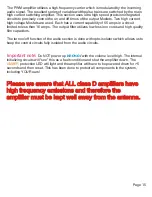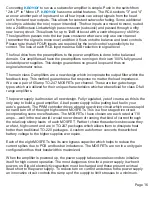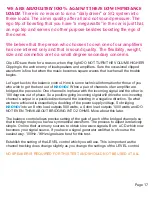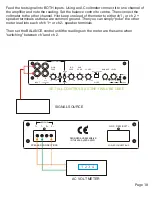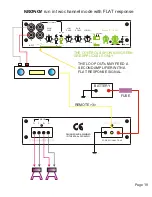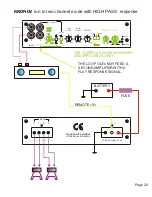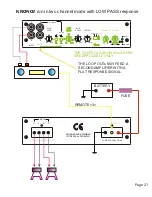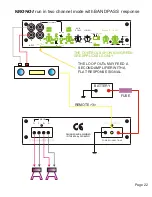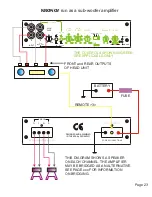
amping Factor - This amplifier specification has been blown out of all proportion.
D
What it means is the ability of the amplifier to resist a change in it’s output voltage.
The formula is DF= Speaker Z / Amplifier output Z (where Z is impedance). So many
manufacturers have claimed ridiculous, and often false damping factors. A damping factor
of 1000 implies that the output impedance of the amplifier is 0.004 ohms (4 ohm load).
The only way to attain this figure is to apply masses of negative feedback (or use positive
feedback) and too much feedback makes amplifiers sound harsh and clinical. Also
damping factor changes with frequency. The lower the frequency the higher the DF
number. Typically the DF can be ten times larger at higher frequencies.
Let us take this amplifier whose output impedance is 0.004 ohms (Zout). The speaker
circuit is a series circuit and the following impedances(resistances) are in series with this
0.004 ohms. Let us assume that this DF measurement was made at the amplifier’s
speaker terminal. The first extra contact resistance is the speaker wire to the speaker
terminal (WT ohms). Then there is that of the wire itself for two conductors (W). Next is
the contact resistance of the wire to the speaker terminal (WS). Next there is the contact
resistance of the wire from the speaker terminal to the voice coil (WV) and lastly there is
the DC resistance of the voice coil itself (DCR). So what we have is a series circuit with
the following resistances in series and adding up. WT+W+WS+WV+DCR+Zout.
WT,W,WS,WV and Zout are very small indeed. Certainly less than 0.1 ohms. Whoa, look
what has happened the EFFECTIVE DAMPING FACTOR has been reduced from 1000 to
40 by just taking into account those pesky unavoidable contact resistances. Now for the
cruncher, remember that the DCR is also in series and is typically 3.2 ohms for a nominal
4 ohm speaker. So we must add 0.1+3.2 = 3.3 ohms and now EFFECTIVE DAMPING
FACTOR is now a magnificent 1.212! (4 divided by 3.3)This is the real world. We see that
the DCR of the speaker swamps all other resistances in the speaker circuit and the 0.004
ohms amplifier output impedance is almost meaningless. It has been found that a DF of
about 20 is quite sufficient to dampen the voltage spikes from the speaker. An eye opener
this one is it not? Good tube amps sound marvelous - low damping factors!!
utput Power of Amplifiers - This spec has been so badly abused it is not even funny.
O
Peak power, Maximum power, Transient power, RMS power these are titles that
have been given to the power spec of amplifiers. The above all mean nothing. Peak
power needs to be associated with a time period, Maximum power is just nonsense,
Transient power is even more nonsense and RMS power is just not a specification. The
ONLY meaningful way to specify an amplifier’s output power in watts is CONTINUOUS
POWER. The formula for power is: (RMS volts x RMS amps) or (RMS volts x RMS
volts/Impedance) or (RMS amps x RMS amps x Impedance). In each of these formulae
there is an RMS number multiplied by another RMS number (or by itself) and RMS x RMS
cannot = RMS.
RMS means
root mean square and it is the same as saying 4 x 4 = 4 Which we know is not true.
The answer is just 4 with no root sign attached.
So THERE IS SIMPLY NO SUCH THING AS RMS POWER.
Page 8

















